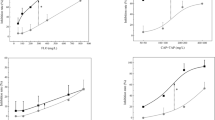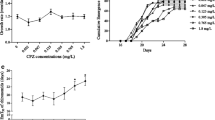Abstract
Current research on prothioconazole (PTC), a broad-spectrum triazole fungicide, mainly focuses on its efficacy and residues; only a few studies have been assessing its toxicological effects. Using acute and chronic toxicity tests, we assessed the effects of PTC and its metabolite prothioconazole-desthio (PTCd) on the inhibition of the activity, growth, and reproduction of Daphnia magna. A dose–response relationship was established to determine sensitive biological indicators. In the acute and chronic toxicity tests, the 48-h EC50 (concentration for 50% of the maximal effect) of PTC and PTCd for D. magna were 2.82 and 5.19 mg/L and 0.0807 and 0.132 mg/L, respectively; in the latter test, PTC was 1.64 times more toxic than PTCd. Acute-to-chronic toxicity ratios were calculated using chronic toxicity data; the ratios were 227 and 27.5 for PTC and PTCd, respectively. Our results indicate that both PTC and PTCd affect the growth and reproduction of D. magna and that the toxicity of PTC is greater than that of PTCd. In conclusion, the metabolites of PTD are toxic to D. magna at certain concentrations, and their environmental risks should not be neglected.


Similar content being viewed by others
Availability of data and materials
Not applicable.
References
Ahlers J, Riedhammer C, Vogliano M, Ebert RU, Kühne R (2006) Acute to chronic ratios in aquatic toxicity-variation across trophic levels and relationship with chemical structure. Environ Toxicol Chem 25:2937–2945
Cardinale BJ, Duffy JE, Gonzalez A, Hooper DU, Perrings C, Venail P, Narwani A, Mace GM, Tilman D, Wardle DA, Kinzig AP (2012) Biodiversity loss and its impact on humanity. Nature 486:59–67
Cassani S, Kovarich S, Papa E, Roy PP, Wal VDW, Gramatica P (2013) Daphnia and fish toxicity of (benzo)triazoles: validated QSAR models, and interspecies quantitative activity–activity modelling. J Hazard Mater 258:50–60
de Almeida ACG, Petersen K, Langford K, Thomas KV, Tollefsen KE (2017) Mixture toxicity of five biocides with dissimilar modes of action on the growth and photosystem II efficiency of Chlamydomonas reinhardtii. J Toxicol Environ Health A 80:971–986
Deb D, Engel BA, Harbor J, Hahn L, Jae Lim K, Zhai T (2010) Investigating potential water quality impacts of fungicides used to combat soybean rust in Indiana. Water Air Soil Pollut 207:273–288
EFSA (2007) Conclusion regarding the peer review of the pesticide risk assessment of the active substance prothioconazole. https://www.efsa.europa.eu/en/efsajournal/pub/rn-106. Accessed 16 Oct 2021
Guo J, Song WH, Ding F, Zhen L, Che XY, Zhang JH, Lian J (2009) Acute toxicity study of triazole fungicides exposure to Daphnia magna. Acta Sci Nat Univ Nankaiensis 42:76–42 (in Chinese with English abstract)
Haas M, Justus K (2005) Metabolism of prothioconazole (JAU 6476) in animals and plants. Pflanzenschutz-Nachr Bayer 57(2):207–224
Hasan MK, Shahriar A, Jim KU (2019) Water pollution in Bangladesh and its impact on public health. Heliyon 5:e02145
Hellpointner E, Borchers H (2005) Behaviour of prothioconazole (JAU 6476) in the environment. Pflanzenschutz-Nachr Bayer 57(2):163–180
Hoaip PM, Sebesvaril Z, Minh TB, Viet PH, Renaud FG (2011) Pesticide pollution in agricultural areas of northern Vietnam: case study in hoang liet and Minh Dai communes. Environ Pollut 159(12):3344–3350
Hu Y, Chen XJ, Yang K, Lin DH (2018) Distinct toxicity of silversilver nanoparticles and silver nitrate to Daphnia magna in M4 medium and surface water. Sci Total Environ 618:838–846
Kim HY, Lee MJ, Yu SH, Kim SD (2012) The individual and population effects of tetracycline on Daphnia magna in multigenerational exposure. Ecotoxicology 21:993–1002
Kühn R, Pattard M, Pernak KD, Winter A (1989) Results of the harmful effects of water pollutants to Daphnia magna in the 21 day reproduction test. Water Res 23:501–510
Lewis SL, Maslin MA (2015) Defining the Anthropocene. Nature 519:171–180
Liu JM, Liu JN, Chen YW, Wang L, Shen SB (2015) Acute and chronic toxicity of tetrabromobisphenol A and tribromophenol on Daphnia magna (Article). Huanjing Kexue Xuebao/acta Scientiae Circumstantiae 35(6):1946–1954
OECD (1998) Guidelines for the testing of chemicals, Daphnia magna: Reproduction test, OECD guideline 211. OECD, Paris
OECD (2006) Guidelines for testing of chemicals: Daphnia sp. Acute immobilisation test. OECD, Paris
Paul PA, Salgado JD, Bergstrom G, Bradley CA, Byamukama E, Byrne AM, Chapara V, Cummings JA, Chilvers MI, Dill-Macky R, Friskop A (2019) Integrated effects of genetic resistance and prothioconazole + tebuconazole application timing on fusarium head blight in wheat. Plant Dis 103:223–237
Rodriguez P, Martinez-Madrid M, Cid A (2006) Ecotoxicological assessment of effluents in the Basque Country (Northern Spain) by acute and chronic toxicity tests using Daphnia magna Straus. Ecotoxicology 15:559–572
Sinclair CJ, Boxall ABA (2003) Assessing the ecotoxicity of pesticide transformation products. Environ Sci Technol 37:4617–4625
Sjerps RMA, Kooij PJF, van Loon A, Van Wezel AP (2019) Occurrence of pesticides in Dutch drinking water sources. Chemosphere 235:510–518
Trösken ER, Straube E, Lutz WK, Völkel W, Patten C (2004) Quantitation of lanosterol and its major metabolite FF-MAS in an inhibition assay of CYP51 by azoles with atmospheric pressure photoionization based LC-MS/MS. J Am Soc Mass Spectrom 15:1216–1221
Trösken ER, Adamska M, Arand M, Zarn JA, Patten C, Völkel W, Lutz WK (2006) Comparison of lanosterol-14α-demethylase (CYP51) of human and Candida albicans for inhibition by different antifungal azoles. Toxicology 228:24–32
Vörösmarty CJ, McIntyre PB, Gessner MO, Dudgeon D, Prusevich A, Green P, Glidden S, Bunn SE, Sullivan CA, Liermann CR, Davies PM (2010) Global threats to human water security and river biodiversity. Nature 467:555–561
Wang PP, Li MM, Liu XG, Xu J, Dong FS, Wu XH, Zheng YQ (2016) Degradation of cyflumetofen and formation of its main metabolites in soils and water/sediment systems. Environ Sci Pollut R 23:23114–23122
Xie Y, Jiang H, Chang J, Wang Y, Li J, Wang H (2019) Gonadal disruption after single dose exposure of prothioconazole and prothioconazole-desthio in male lizards (Eremias argus). Environ Pollut 255:113297
Yuan CJ (2012) Individual and combined toxic effects of chloroacetonitrile, aniline, and malathion on water flea. National Chiao Tung University, Taiwan, pp 68–69 (in Chinese with English abstract)
Zhai WJ, Zhang LL, Cui JN, Wei YM, Wang P, Liu DH (2019) The biological activities of prothioconazole enantiomers and their toxicity assessment on aquatic organisms. Chirality 31:468–475
Zhang Z, Gao B, Li L, Zhang Q, Xia W, Wang M (2018) Enantioselective degradation and transformation of the chiral fungicide prothioconazole and its chiral metabolite in soils. Sci Total Environ 634:875–883
Zhang Z, Zhang J, Zhao X, Gao B, He Z, Li L, Shi H, Wang M (2020) Stereoselective uptake and metabolism of prothioconazole caused oxidative stress in zebrafish (Danio rerio). J Hazard Mater 396:122756
Author information
Authors and Affiliations
Contributions
All authors contributed to the study conception and design. LX, JJ, WF, LL, LG, WS, and ZX prepared the material and performed data collection and analysis. AX wrote the first draft of the manuscript, and all authors commented on the previous versions of the manuscript. All authors read and approved the final manuscript.
Corresponding author
Ethics declarations
Ethics approval and consent to participate
Not applicable
Consent for publication
Not applicable
Competing interests
The authors declare no competing interests.
Additional information
Responsible Editor: Bruno Nunes
Publisher's note
Springer Nature remains neutral with regard to jurisdictional claims in published maps and institutional affiliations.
Rights and permissions
About this article
Cite this article
Xuehua, A., Xinju, L., Jinhua, J. et al. Acute and chronic toxicities of prothioconazole and its metabolite prothioconazole-desthio in Daphnia magna. Environ Sci Pollut Res 29, 54467–54475 (2022). https://doi.org/10.1007/s11356-021-17863-y
Received:
Accepted:
Published:
Issue Date:
DOI: https://doi.org/10.1007/s11356-021-17863-y




